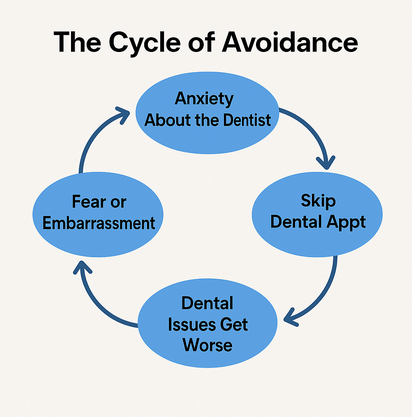If you’ve been avoiding the dentist because of fear or anxiety, you’re not alone.
I’ve met countless patients who felt embarrassed, nervous, or downright terrified to sit in the dental chair. Many of them hadn’t been to a dentist in years. And almost all of them had fallen into what I call the cycle of avoidance—a pattern that keeps you stuck and your oral health in limbo.
The good news? That cycle can be broken—and you don’t have to do it all at once. In this blog, I’ll walk you through five simple, compassionate steps to help you move forward (at your own pace).
What Is the Cycle of Avoidance?
It looks like this:

And the cycle repeats…
Even if you used to go to the dentist regularly, a single bad experience, your busy life, or a growing fear of judgment can keep you away for years.
And the longer you wait, the harder it feels to return.
But here’s what I want every anxious patient to hear: you are not broken, and you are not alone. Dental fear is incredibly common, and there are real, manageable ways to move through it. And let’s face it, going to the dentist is generally not in one’s list of “My favorite things to do.” But it need not be something to be dreaded, feared or avoided.
1. Start Small—Really Small
Your return to dental care doesn’t have to involve a cleaning, a drill, or even lying back in the chair.
It can be as simple as:
- Making a phone call and being greeted with a warm friendly hello. The initial phone contact can be so important. (One of the first things I tell a new member of my team is that before you pick up a ringing telephone, “Stop what your’re doing and SMILE….then answer the call.) A smile goes a long way to break the ice and dispel unease and I believe that the caller can actually “feel” a welcoming smile.
- Walking into the office just to look around. Your first impression, the initial vibe of the place should be warm, welcoming, and safe. (But it’s always good to call in advance.)
- Scheduling a no-pressure consultation (no treatment, no tools). I actually think of this more as a meet and greet rather than a more formal consultation. There is nothing more calming than a friendly smile and an empathetic listener.
Many of my patients tell me that the scariest part was making the first move. Once they walked through the door, things started to feel a little easier. Procrastination can perpetuate and exacerbate dental anxiety.
2. Talk About Your Fear
To a phobic or anxious person, thoughts of a typical dental office can be very intimidating. Being open about your trepidations can help lighten the burden that often accompanies fear.
Let your dental team know if you’re:
- Nervous about pain
- Embarrassed about how long it’s been
- Afraid of being judged
- Triggered by certain sights, sounds, or smells
A caring dental office will respond with patience, empathy, and a reassuring path forward to help you feel safe. You should never feel rushed, dismissed, or pressured.
3. Bring a Buddy
Never underestimate the power of support.
Having a trusted friend, spouse, or sibling by your side can make a huge difference. Whether they sit in the waiting room or come into the exam room with you, their presence can help ground you and ease your anxiety.
Bonus: they’ll also keep you accountable to your goals—and maybe even reward you with a post-visit coffee or cupcake!
4. Let Go of Shame
This is often the hardest part.
I’ve had patients cry in the chair—not because of pain, but because of relief. Relief that they weren’t judged. That they were met with kindness. That someone finally said, “You’re not the only one.”
If you’ve avoided the dentist for years, that’s okay. If you feel embarrassed about your teeth, that’s okay too. My role is to find a path forward that is right for you. I’m here to help you, not to judge you.
People come in all shapes and sizes. A one-size-fits-all all approach to dental care is doomed to disappoint. Each and every one of us is uniquely… unique. I liken patients to musical instruments. And my task is to find what melody resonates with you so that the care I provide for you is harmonious with your wants and needs.
5. Find a Dentist Who Focuses on Comfort
This is important. Not all dental practices are the same.
Look for one that emphasizes:
- Gentle, unrushed appointments
- Warm, friendly staff
- Calming extras like blankets, music, or noise-canceling headphones
- Sedation options, if needed
- A doctor who takes the time to listen.
- A doctor who understands the difference between doing something TO a patient versus one who is doing something FOR his patient.
If you’re in New York City and searching for this kind of care, I’d be honored to help you. My team and I have created a space where anxious patients feel safe, seen, and truly cared for.
Ready to Take the First Step?
There’s no pressure, no lecture, and no judgment—just a warm welcome and a conversation about what feels comfortable for you.
Call our office at (212) 685-3040. Let’s take that first step together.
Michael Sinkin, DDS MAGD
Learn more about Dr. Sinkin here: Meet Doctor Sinkin
You may also be interested in:

